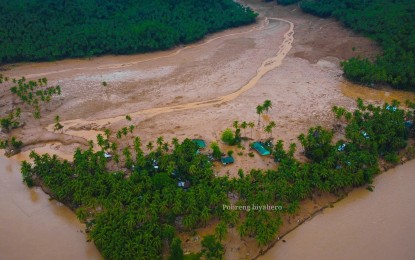
WIPED OUT. A landslide-hit farming community in Baybay City, Leyte in this April 11, 2022 photo. A soil scientist has warned that “incipient” landslides caused by Tropical Depression Agaton in Baybay may trigger deadly landslides. (Photo courtesy of Pobreng Biyahero)
TACLOBAN CITY – A soil scientist on Wednesday warned that “incipient” landslides caused by Tropical Depression Agaton in Baybay City may trigger major landslides in the future.
The situation, according to Visayas State University Professor Victor Asio, calls for the need to come up with more detailed and updated geohazard maps of communities in the city that are vulnerable to landslides.
“I suspect that several incipient landslides (landslides in the initial stage) were produced in various areas during 'Agaton' but are hidden by the vegetation cover. Another storm or typhoon may trigger these landslide incidents to become full or even catastrophic landslides,” Asio said in a phone interview.
Examining the surroundings of landslide-hit communities in the city, Asio said there were landslides in the past decades, but overlooked since the area was still uninhabited.
“Through more detailed and updated hazard map, residents living in landslide-prone areas will be given proper and timely attention,” Asio added.
In his research published online on April 21, the soil science expert who has been in the field for 30 years, presented his analysis of the April 10 landslide incident that killed at least 128 people with over a hundred missing.
“The Baybay landslides were triggered by the extremely heavy rainfall and enhanced by the unstable and highly weathered soils, weak geologic material composed of pyroclastic rocks, and the steep slopes,” he said.
Asio explained that “Agaton” dumped a tremendous volume of rain from April 9 to 11 — a “whopping” 907mm (millimeter) — amounting to four months of rain, but poured in Baybay in just three days.
No vegetation type on hillsides can absorb and evaporate the huge volume of water in so short a time, according to him.
“Trees and plants can only do so much, since it can partly prevent shallow landslides, but not deep-seated landslides such as those in Bunga, Kantagnos, and Mailhi villages. This means that the coconut's shallow root system (about a meter deep) may not have effectively prevented the landslides, but the same can be said of the trees with their two- to three-meter-deep rooting zone since the landslides are several meters deep in their source areas,” Asio added.
In a brief phone interview, Mines and Geoscience Bureau (MGB) Eastern Visayas geologist in charge Leandrew Luz said assessment is still ongoing in landslide-hit areas, and they have already initially identified five villages as danger zones.
The MGB regional office is to present the result of their initial assessment next week. (PNA)
